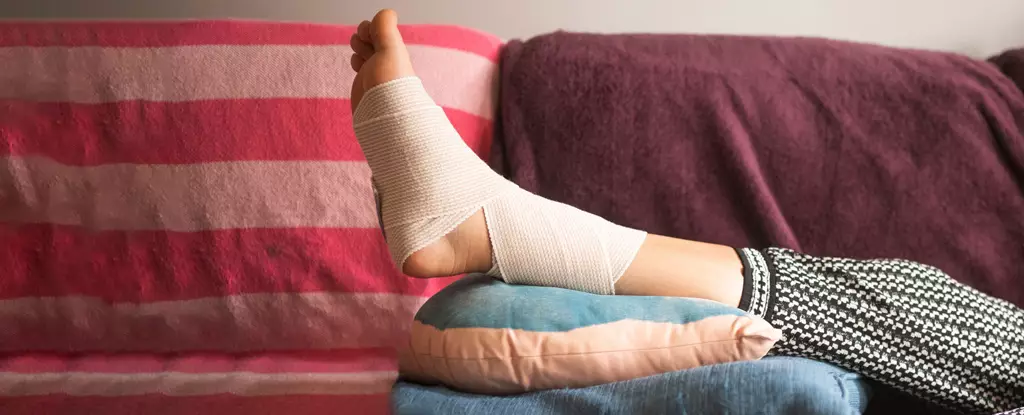When one thinks of an ankle sprain, the immediate response is often centered on physical pain and mobility issues. However, emerging research proposes a vastly different perspective—one that suggests our understanding of physical injuries should extend beyond mere bodily harm to encompass the brain’s adaptive capabilities. This phenomenon, known as brain plasticity, indicates that the mind can change and restructure itself, especially in response to bodily injuries. The notion that an injury at the ankle may also influence brain function invites a critical reevaluation of how we approach rehabilitation and injury prevention.
A compelling study conducted by doctoral student Ashley Marchant illuminates the relationship between sensory perception and physical exertion. The findings reveal that our ability to accurately gauge movement is heavily influenced by the gravitational load we experience. When the external load mirrors the force of Earth’s gravity, our sense of movement remains sharp. Conversely, as the load decreases, so does our movement accuracy. This indicates a fundamental aspect of rehabilitation: the need for a holistic understanding of the brain’s role in processing sensory information during our recovery efforts.
Traditionally, rehabilitation for injured athletes has revolved around resistance training, cardiovascular exercise, and flexibility routines. However, this strategy might be fundamentally flawed, especially given that athletes returning from sports-related injuries face a significantly elevated risk of re-injury—often two to eight times higher than their uninjured peers. This disparity challenges the effectiveness of conventional rehabilitation paradigms.
At the intersection of movement science and sensory perception lies a pioneering approach unearthed by researchers at the University of Canberra and the Australian Institute of Sport. By focusing on sensory input, these researchers aim to unravel the complexities surrounding how the brain interprets movement signals, nurturing a more comprehensive rehabilitation process.
The data shows that input nerves vastly outnumber output nerves; with the sensory network comprising roughly ten times as many connections as the motor pathways. This imbalance stresses the importance of accurate sensory reception for effective movement. By measuring how well individuals perceive sensory input from various systems—namely, the vestibular system (responsible for balance), the visual system (sensitive to light changes), and proprioception (derived from muscles and skin around the lower limbs)—researchers can better understand how the brain interprets movement data.
Consider astronauts aboard the International Space Station, where they must adapt to an environment devoid of Earth’s gravity. The resultant lack of sensory feedback from the legs drastically alters their ability to control movement upon returning to Earth. Their brains deactivate previously established movement pathways, leading to an increased likelihood of falls and injury upon reentry into a gravity-sustaining environment.
This concept parallels the situation of athletes who develop altered movement patterns due to injury. For instance, a limp induced by a leg injury may lead the brain to form new, less optimal movement strategies. In the context of brain plasticity, these movement control patterns might never quite return to their pre-injury state, contributing to the cycle of re-injury.
Interestingly, early assessments of an athlete’s sensory perception might serve as predictive measures for their performance in sports. The same principles apply to older individuals, as poorer sensory perception may correlate with a higher likelihood of falls—potentially linked to decreased physical activity levels. The adage “use it or lose it” underscores how a lack of exercise may diminish brain connections vital for movement perception and control over time.
In health care, advancing technologies and artificial intelligence are paving the way for a system termed precision health. This methodology combines multiple factors, including genetic predispositions, to tailor individualized treatment plans. Applying a precision health framework to movement control could revolutionize rehabilitation for athletes, enhance navigational skills for astronauts, and proactively prevent falls among older adults.
The traditional interpretations of injuries and rehabilitation have long prioritized the physical manifestations of harm over the intricacies of brain function. As our understanding of brain plasticity and sensory perception grows, there is a pressing need to integrate these insights into the biomechanical model of rehabilitation. By prioritizing a more comprehensive approach, we can better equip ourselves to deal with the realities of re-injury, develop emerging athletic talent, and safeguard older individuals against the dangers of falling—a shift that could vastly improve health outcomes across diverse populations. The future of movement science lies in our ability to bridge the gap between the brain and body, weaving their narratives into a singular story of resilience and recovery.


Leave a Reply